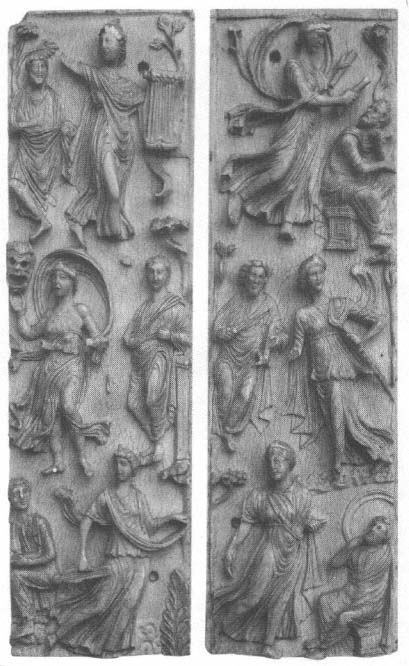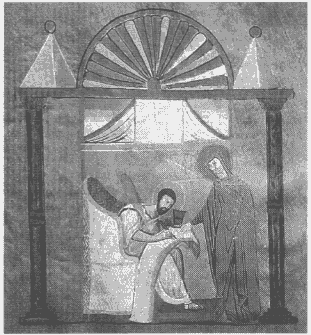The Power of the Muses
The source of all poetry and thought was the Muses, daughters of Zeus and Mnemosyne. From them flowed all knowledge and inspiration. Thus I would like to end this final chapter with a glance at the Muses, and not only to pay them due respect. The fact is, they had never before assumed such a powerful role in the visual arts as they did in the Late Antique. When the thought process itself is directed at divine revelation, then all intellectual activity can be perceived only as a form of divine dispensation or grace. These in turn are transmitted to man by divine creatures, Muses or angels.
In the Hellenistic world, the conception of the intellectual enterprise was informed by the notion of individual will. The figure of the thinker himself, with his energy and concentration, was the focus of attention. This affected the Muses too, for they were sometimes depicted immersed in deep meditation as well. In this process, the mythological relationship of Muse and poet could even be inverted, so
highly prized were the achievements of the creative intellectual. At the opening of the Argonautica, Apollonius invokes the Muses, but only as "servants" of his composition. They are no longer, as for Homer and the early poets, the Muses from whom all song emanates.[78] Similarly, on a well-known Hellenistic votive relief in the Palazzo dei Conservatori in Rome, the Muse looks up to a blind old poet like an adoring schoolgirl to her teacher.[79]
But in the course of the Roman period, the pendulum swung once again in favor of the Muses. Now there is scarcely a poet, philosopher, or scholar who does not appear along with his Muse. But the relationship between the two seems now more direct and personal. This is especially clear on the sarcophagi that show husband and wife as teacher and Muse, seated or standing opposite one another, since here the pairing of intellectual and Muse serves also as a metaphor for conjugal harmony (concordia; cf. fig. 147). The mosaic in Madrid that depicts several intellectuals with their Muses against a villa setting has already been mentioned. The Muses have grown in stature; in some scenes they no longer stand quietly, and their vivid expressions seem to be having a powerful impact on their protégés. On the beautiful diptych in ![]() Monza
Monza ![]() , a poet with shaved head listens with rapt attention to the chords of his kithara-playing Muse. His inspiration comes not from the writings strewn carelessly on the ground, but from the Muse and her song.[80]
, a poet with shaved head listens with rapt attention to the chords of his kithara-playing Muse. His inspiration comes not from the writings strewn carelessly on the ground, but from the Muse and her song.[80]
A diptych of the fifth century in the Louvre presents the Muses as mighty, elemental forces who literally "come over the poets," dancing and flying like the Angel of the Annunciation (fig. 178). The poets, who simply watch and listen, are reduced to purely passive roles.[81] Meanwhile, the Muses themselves have turned into learned figures: Calliope (or perhaps Clio) reads to her charge from a book roll the words that he is to write down!
The notion of spiritual inspiration that marked Late Hellenism and the Christian belief in the creation of Holy Writ through the agency of celestial powers are in essence the same. And this general picture will obtain well into the Middle Ages: wisdom is a mercy that comes directly from God, transmitted by his messengers. This is vividly
Fig. 178
Ivory diptych showing poets with their Muses. Fifth century A.D. Paris, Louvre.
Fig. 179
Illuminated codex: an angel (?) assists Saint Mark in writing
the Gospel. Sixth century A.D. Archepiscopal Library, Rossano.
illustrated in the Rossano Gospels, where a female personification—or is she an angel without wings?—has taken the place of the Muse and dictates word for word to Saint Mark, even going over with her finger and checking what he has just written (fig. 179).[82] The concept of the transmission of knowledge will from now on be dominated by such images of authority. The medieval teacher sits or stands elevated above his pupils and dictates to them. This stereotypical image will long help shape the iconography of the university.[83]
There is a corresponding change in the representation of the book. Instead of a simple attribute that the learned man holds or ponders, it becomes a spiritually charged cultural icon whose power is aimed di-
rectly at the viewer. As in the scenes of teacher and pupils, the image speaks directly to the viewer, and Christ, the saints, and evangelists hold the roll or codex up to him. It makes no difference if the codex is open or only the richly ornamented binding is displayed. Salvation springs from the Holy Scripture, and the assurance of the truth revealed: seeing is believing.[84]

